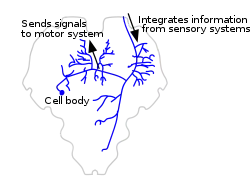Interneuron
Interneurons (also called internuncial neurons, relay neurons, association neurons, connector neurons, intermediate neurons or local circuit neurons) are neurons that connect two brain regions, i.e. not direct motor neurons or sensory neurons. Interneurons are the central nodes of neural circuits, enabling communication between sensory or motor neurons and the central nervous system (CNS).[2] They play vital roles in reflexes, neuronal oscillations,[3] and neurogenesis in the adult mammalian brain.
| Interneuron | |
|---|---|
 Cartoon of a locust interneuron that integrates information about wind in order to control wing motor neurons during flight[1] | |
| Details | |
| Location | Nervous system |
| Identifiers | |
| MeSH | D007395 |
| NeuroLex ID | birnlex_2534 |
| TH | H2.00.06.1.00058 |
| FMA | 67313 |
| Anatomical terms of neuroanatomy | |
Interneurons can be further broken down into two groups: local interneurons and relay interneurons.[4] Local interneurons have short axons and form circuits with nearby neurons to analyze small pieces of information.[5] Relay interneurons have long axons and connect circuits of neurons in one region of the brain with those in other regions.[5] However, interneurons are generally considered to operate mainly within local brain areas.[6] The interaction between interneurons allow the brain to perform complex functions such as learning, and decision-making.
Structure
In the neocortex (making up about 80% of the human brain), approximately 20–30% of neurons are interneurons.[7] Investigations into the molecular diversity of neurons is impeded by the inability to isolate cell populations born at different times for gene expression analysis. An effective means of identifying coetaneous interneurons is neuronal birthdating.[8] This can be achieved using nucleoside analogs such as EdU.[9][8]
In 2008, a nomenclature for the features of GABAergic cortical interneurons was proposed, called Petilla terminology.[10]
Spinal cord
- Ia inhibitory interneuron: Found in lamina VII. Responsible for inhibiting antagonist motor neuron. 1a spindle afferents activate 1a inhibitory neuron.
- Ib inhibitory interneuron: Found in lamina V, VI, VII. Afferent or Golgi tendon organ activates it.
 A spinal interneuron (relay neuron) forms part of a reflex arc
A spinal interneuron (relay neuron) forms part of a reflex arc
Cortex
- Parvalbumin-expressing interneurons
- CCK-expressing interneurons
- VIP-expressing interneurons
- SOM-expressing interneurons[11]
Cerebellum
Striatum
- Parvalbumin-expressing interneurons[12]
- Cholinergic interneurons[13][14]
- Tyrosine hydroxylase-expressing interneurons[15]
- Calretinin-expressing interneurons[16]
- Nitric oxide synthase-expressing interneurons[16]
Function
Interneurons in the CNS are primarily inhibitory, and use the neurotransmitter GABA or glycine. However, excitatory interneurons using glutamate in the CNS also exist, as do interneurons releasing neuromodulators like acetylcholine. Interneurons main function is to provide a neural circuit, conducting flow of signals or information between a sensory neuron and or motor neuron.
See also
- Relay (disambiguation)
References
- Pearson, K. G. and Wolf, H. Connections of hindwing tegulae with flight neurones in the locust, Locusta migratoria. J. Exp. Biol. 135: 381-409, 1988
- "Types of neurons - Queensland Brain Institute - University of Queensland". 9 November 2017.
- Whittington, M.A; Traub, R.D; Kopell, N; Ermentrout, B; Buhl, E.H (2000). "Inhibition-based rhythms: Experimental and mathematical observations on network dynamics". International Journal of Psychophysiology. 38 (3): 315–36. CiteSeerX 10.1.1.16.6410. doi:10.1016/S0167-8760(00)00173-2. PMID 11102670.
- Carlson, Neil R. (2013). Physiology of Behavior (11th ed.). Pearson Higher Education. p. 28. ISBN 978-0-205-23939-9.
- Kandel, Eric; Schwartz, James; Jessell, Thomas, eds. (2000). Principles of Neural Science (4th ed.). New York City, New York: McGraw Hill Companies. p. 25. ISBN 978-0-8385-7701-1.
- Kepecs, Adam; Fishell, Gordon (2014). "Interneuron Cell Types: Fit to form and formed to fit". Nature. Nature , 2014 HHS Public Access pp 10, 28. 505 (7483): 318–326. doi:10.1038/nature12983. PMC 4349583. PMID 24429630.
- Markram, Henry; et al. (2004). "Interneurons of the neocortical inhibitory system". Nature Reviews Neuroscience. 5 (10): 793–807. doi:10.1038/nrn1519. PMID 15378039. S2CID 382334.
- Ng, Hui Xuan; Lee, Ean Phing; Cavanagh, Brenton L.; Britto, Joanne M.; Tan, Seong-Seng (2017). "A method for isolating cortical interneurons sharing the same birthdays for gene expression studies". Experimental Neurology. 295: 36–45. doi:10.1016/j.expneurol.2017.05.006. PMID 28511841. S2CID 3377296.
- Endaya, Berwini; Cavanagh, Brenton; Alowaidi, Faisal; Walker, Tom; Pennington, Nicholas de; Ng, Jin-Ming A.; Lam, Paula Y.P.; Mackay-Sim, Alan; Neuzil, Jiri (2016). "Isolating dividing neural and brain tumour cells for gene expression profiling". Journal of Neuroscience Methods. 257: 121–133. doi:10.1016/j.jneumeth.2015.09.020. PMID 26432933. S2CID 44969376.
- Ascoli, Giorgio A.; Alonso-Nanclares, Lidia; Anderson, Stewart A.; Barrionuevo, German; Benavides-Piccione, Ruth; Burkhalter, Andreas; Buzsáki, György; Cauli, Bruno; Defelipe, Javier; Fairén, Alfonso; Feldmeyer, Dirk; Fishell, Gord; Fregnac, Yves; Freund, Tamas F.; Gardner, Daniel; Gardner, Esther P.; Goldberg, Jesse H.; Helmstaedter, Moritz; Hestrin, Shaul; Karube, Fuyuki; Kisvárday, Zoltán F.; Lambolez, Bertrand; Lewis, David A.; Marin, Oscar; Markram, Henry; Muñoz, Alberto; Packer, Adam; Petersen, Carl C. H.; Rockland, Kathleen S.; et al. (2008). "Petilla terminology: Nomenclature of features of GABAergic interneurons of the cerebral cortex". Nature Reviews Neuroscience. 9 (7): 557–68. doi:10.1038/nrn2402. PMC 2868386. PMID 18568015.
- Muñoz, W; Tremblay, R; Levenstein, D; Rudy, B (3 March 2017). "Layer-specific modulation of neocortical dendritic inhibition during active wakefulness". Science. 355 (6328): 954–959. Bibcode:2017Sci...355..954M. doi:10.1126/science.aag2599. PMID 28254942.
- Tepper, James M.; Koós, Tibor (1999). "Inhibitory control of neostriatal projection neurons by GABAergic interneurons". Nature Neuroscience. 2 (5): 467–72. doi:10.1038/8138. PMID 10321252. S2CID 16088859.
- Zhou, Fu-Ming; Wilson, Charles J.; Dani, John A. (2002). "Cholinergic interneuron characteristics and nicotinic properties in the striatum". Journal of Neurobiology. 53 (4): 590–605. doi:10.1002/neu.10150. PMID 12436423.
- English, Daniel F; Ibanez-Sandoval, Osvaldo; Stark, Eran; Tecuapetla, Fatuel; Buzsáki, György; Deisseroth, Karl; Tepper, James M; Koos, Tibor (2011). "GABAergic circuits mediate the reinforcement-related signals of striatal cholinergic interneurons". Nature Neuroscience. 15 (1): 123–30. doi:10.1038/nn.2984. PMC 3245803. PMID 22158514.
- Ibanez-Sandoval, O.; Tecuapetla, F.; Unal, B.; Shah, F.; Koos, T.; Tepper, J. M. (2010). "Electrophysiological and Morphological Characteristics and Synaptic Connectivity of Tyrosine Hydroxylase-Expressing Neurons in Adult Mouse Striatum". Journal of Neuroscience. 30 (20): 6999–7016. doi:10.1523/JNEUROSCI.5996-09.2010. PMC 4447206. PMID 20484642.
- Ibáñez-Sandoval, Osvaldo; Koós, Tibor; Tecuapetla, Fatuel; Tepper, James M. (2010). "Heterogeneity and Diversity of Striatal GABAergic Interneurons". Frontiers in Neuroanatomy. 4: 150. doi:10.3389/fnana.2010.00150. PMC 3016690. PMID 21228905.